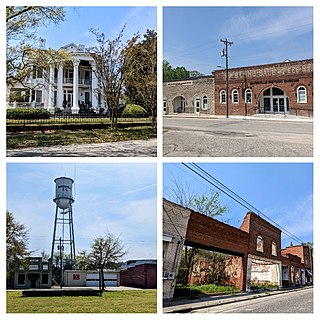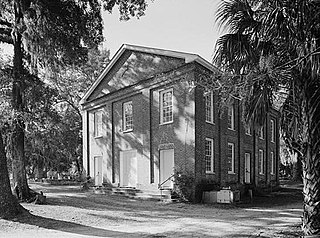
Mayesville is a town in Sumter County, South Carolina, United States. The population was 731 at the 2010 census, this was a decline from 1,001 in 2000. It is included in the Sumter, South Carolina Metropolitan Statistical Area.

The Old Campus District, University of South Carolina, is a historic district centered on The Horseshoe on the main campus of the University of South Carolina in Columbia, South Carolina. On June 5, 1970, it was listed in the National Register of Historic Places. On April 19, 1996 MTV Unplugged filmed Hootie & the Blowfish's concert on The Horseshoe before the release of their second album Fairweather Johnson.
James McBride Dabbs Jr. (1937–2004) was a social psychologist and professor of psychology at Georgia State University. Born in 1937 in Sumter, South Carolina, he obtained his doctorate from Yale in 1962. In 2004, he died from cancer.

Mulberry Plantation, also known as the James and Mary Boykin Chesnut House is a historic plantation at 559 Sumter Highway south of Camden, South Carolina. Declared a National Historic Landmark in 2000, it is significant as the home of American Civil War chronicler Mary Boykin Chesnut, who produced some of the most important written accounts of the war from a Confederate perspective. The main house, built about 1820, is a fine example of Federal period architecture.

The Penn Center, formerly the Penn School, is an African-American cultural and educational center in the Corners Community on Saint Helena Island. Founded in 1862 by Quaker and Unitarian missionaries from Pennsylvania, it was the first school founded in the Southern United States specifically for the education of African-Americans. It provided critical educational facilities to Gullah slaves freed after plantation owners fled the island, and continues to fulfill an educational mission. Leigh Richmond Miner photographed students and activities at the school.

Millford Plantation is a historic farmstead and plantation house located on SC 261 west of Pinewood, South Carolina. It was sometimes called Manning's Folly, because of its remote location in the High Hills of Santee section of the state and its elaborate details. Designated as a National Historic Landmark, it is regarded as one of the finest examples of Greek Revival residential architecture in the United States. The house has been restored and preserved along with many of its original Duncan Phyfe furnishings.

The Stateburg Historic District is a historic district in Stateburg, in the High Hills of Santee area near Sumter, South Carolina in the United States. It includes two National Historic Landmarks, Borough House Plantation and the Church of the Holy Cross, and at least eight contributing properties within its boundaries. On February 24, 1971, it was added to the National Register of Historic Places. The historic district extends north and east of the town of Stateburg as far north as Meeting House Road and as far east as South Carolina Highway 441, covering an area of 5,066 acres (20.50 km2).

The High Hills of Santee, sometimes known as the High Hills of the Santee, is a long, narrow hilly region in the western part of Sumter County, South Carolina. It has been called "one of the state's most famous areas". The High Hills of Santee region lies north of the Santee River and east of the Wateree River, one of the two rivers that join to form the Santee. It extends north almost to the Kershaw county line and northeasterly to include the former summer resort town of Bradford Springs. Since 1902 the town has been included in Lee County.

Orange Grove, also known as the Gaillard-Colclough House, is an historic 39.9-acre (161,000 m2) plantation and its plantation house at Gaillard's Crossroads,, north of Dalzell, South Carolina. It was added to the National Register of Historic Places on August 19, 1993.

Salem Black River Presbyterian Church is a historic church in Sumter, South Carolina.

The Heriot-Moise House, also known as Ingleside, is an historic plantation house located on Brewington Road at Oswego Highway U.S Highway 401 north of Sumter in Sumter County, South Carolina. It is "significant for its illustration of evolving architectural forms and influences from ca. 1790 into the twentieth century, as altered from an essentially vernacular hall-and-parlor house to a residence with Early Classical revival and Greek revival influences. Extant features from the original house and the ca. 1800, ca. 1830, ca. 1850, and later alterations show how succeeding owners adapted the house to their changing needs and circumstances. It is also significant as a basically intact nineteenth and early twentieth century farm complex."

The Brattonsville Historic District is a historic district and unincorporated community in York County, South Carolina. It includes three homes built between 1776 and 1855 by the Brattons, a prominent family of York County. It was named to the National Register of Historic Places in 1971.

Marshlands Plantation House, in Charleston, South Carolina, is an historic plantation house that was built in 1810 and listed in the National Register of Historic Places on March 30, 1973. It is a 2+1⁄2-story Federal-style plantation home. The house was relocated in the 1960s from its original location on the site of the United States Navy Shipyard. The Navy had announced it would have to demolish the empty house if it could not be relocated with the $15,000 the Navy had set aside for the purpose. The City of Charleston took temporary possession of the house, transferring it to the College of Charleston which relocated it for preservation to James Island.

Landsford Plantation House, also known as the Davie House, is a historic plantation house located near Richburg, Chester County, South Carolina. It was built about 1828, and is a 2+1⁄2-story, timber-framed weatherboarded vernacular residence. The house has a square plan and is two rooms deep. The main façade featured a one-story porch, resting on brick piers, and added about the turn of the 20th century. Landsford Plantation achieved local prominence as the social center of a 3,000 acres (1,200 ha) Piedmont cotton plantation in the mid-19th century. Of the original outbuildings, only a barn of log construction remains.
Laurelwood is a historic plantation house located in rural Richland County, South Carolina, near the city of Eastover. It was built about 1830, and is a two-story frame dwelling with a central-hall, double-pile plan. The front façade features a two-tier, three bay, pedimented portico in the Greek Revival style. It has a one-story, frame addition built in the early-20th century. Also on the property are the contributing frame smokehouse and a frame barn. Also notable is the survival of a slave quarters.
Myrtle Moor is a historic plantation house located near Sumter, Sumter County, South Carolina. It was built about 1825–1840, and is a large, two-story, L-shaped frame farmhouse embellished with vernacular interpretations of the Federal and Greek Revival styles.. The front façade features a one-story full-shed-roof porch supported by six chamfered wooden posts. Also on the property are the contributing commissary, a barn, and a speculated servants' quarters/kitchen.

Carnegie Public Library is a historic Carnegie library building located at Sumter, Sumter County, South Carolina. It was built in 1916–1917, and is a two-story, brick Beaux-Arts style building. The front facade features four arched windows with limestone surrounds and the main entryway flanked by two Ionic order columns. It was one of the 1,679 public libraries built in the United States with funding from the Carnegie Corporation. The Sumter library was constructed with $10,000 provided by the Carnegie Corporation. It housed the public library until 1968, and afterwards housed a local genealogical society.
Middleton's Plantation, also known as Chisolm's Plantation and The Launch, is a historic plantation house located near Edisto Island, Charleston County, South Carolina. It was built about 1830, and is a two-story wooden house, with one-room wings. It sits on a raised arcaded brick basement. It features a small Tuscan order colonnaded porch on the land side facade and a recessed, full width, Tuscan order colonnaded porch on the water side. It was the home of Oliver Hering Middleton, son of Governor Henry Middleton of Middleton Place.

James McBride Dabbs was an American author and farmer from South Carolina known for his writings on religion and Southern culture. He has been recognized as one of the South's leading liberals during his time. Dabbs was cited in Martin Luther King Jr.'s Letter from Birmingham Jail as a Southern writer who wrote about the struggle of African Americans in "eloquent and prophetic terms." He has also been called the only native Southern critic during the civil rights movement who saw "more good than ill in the Southern tradition."
Edith Mitchell Dabbs was an American Civil rights activist and writer from South Carolina known for her focus on Saint Helena and Penn Center. She was married to James McBride Dabbs whom she assisted with editing. Dabbs was one of the only authors to write about Saint Helena Island during her time. However, though her books continue to be cited, they were initially dismissed by some historians for not following the best practices of historic scholarship.


















